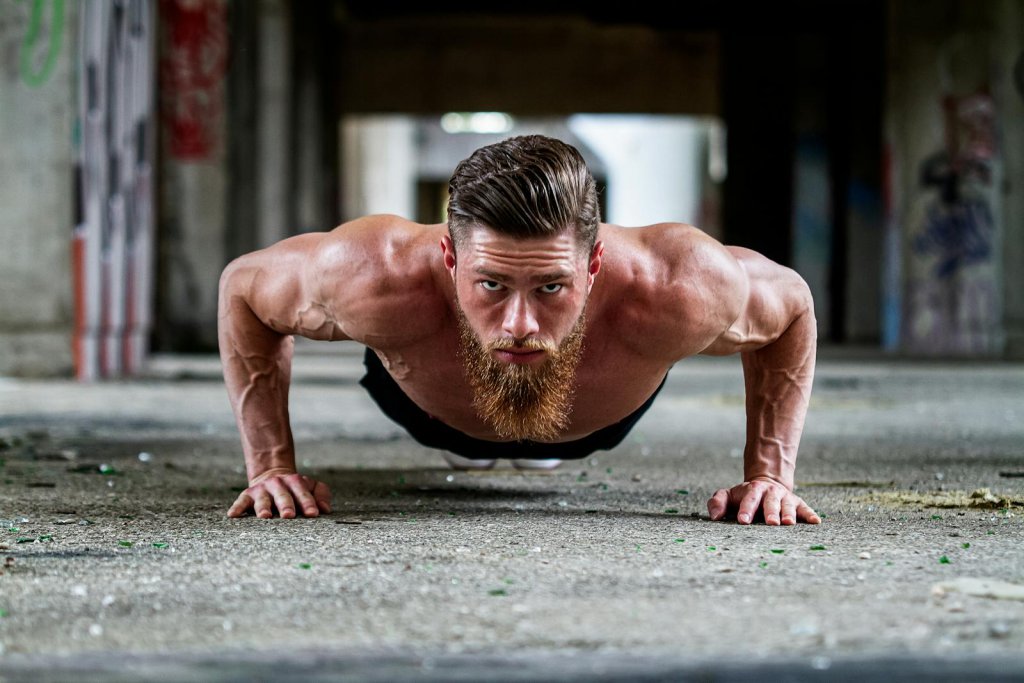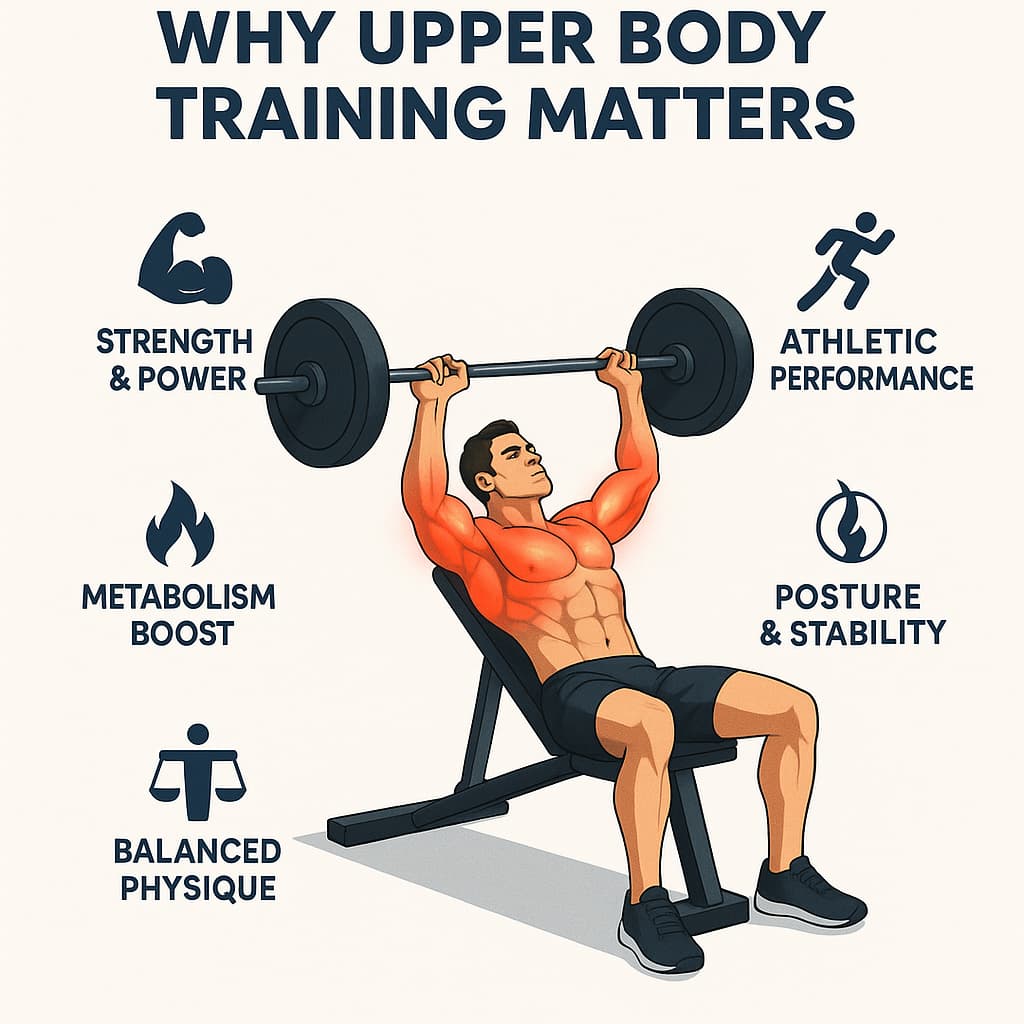The best upper body workouts for men combine push, pull, and core-stabilizing movements to build muscle, strength, and definition.
If your goal is to sculpt a powerful chest, wide back, and defined arms, mastering these exercises is key.

Upper body training isn’t just about looks — it improves posture, athletic performance, and long-term joint health.
This guide covers the 15 best exercises for your chest, shoulders, back, biceps, triceps, and core — with expert form tips, science-backed benefits, and workout structure advice for all levels.
Why Upper Body Training Matters
According to a 2024 study in the Journal of Strength & Conditioning Research, training the upper body 2–3 times per week led to comparable gains in strength and muscle size over 10 weeks when total training volume was matched.

Key Benefits:
- Increased upper-body strength and power
- Improved athletic performance and lifting efficiency
- Enhanced metabolism and calorie burn
- Better posture and shoulder stability
- Balanced physique for aesthetics and functionality
15 Best Upper Body Workouts for Men
Each exercise below includes why it works, muscles targeted, how to do it, and a trainer tip for best results.
1. Barbell Bench Press
Why it works:
The king of all upper-body mass builders — activates your chest, triceps, and shoulders simultaneously. It’s a compound lift that allows you to move heavy weight, stimulating maximum muscle growth and strength.
Muscles worked:
Pectoralis major, anterior deltoid, triceps brachii, core stabilizers.
How to do it:
- Lie flat on a bench with feet firmly on the floor.
- Grip the bar slightly wider than shoulder-width.
- Lower the bar under control to mid-chest level.
- Drive through your heels and press the bar upward until elbows are locked out.
Trainer Tip:
Retract your shoulder blades to protect your shoulders and ensure full chest engagement. Avoid bouncing the bar off your chest.
2. Incline Dumbbell Press
Why it works:
Targets the upper portion of your chest and anterior deltoids, giving your chest a fuller, more aesthetic shape.
Muscles worked:
Upper pectorals, anterior deltoids, triceps brachii.
How to do it:
- Adjust a bench to a 30–45° incline.
- Hold dumbbells directly above your chest, palms facing forward.
- Lower both dumbbells slowly until elbows are at chest level.
- Press back up until arms are fully extended.
Trainer Tip:
Don’t let the dumbbells touch at the top — keeping tension on the chest maximizes muscle fiber activation.
3. Pull-Ups (Wide Grip)
Why it works:
A bodyweight staple for width and V-taper — builds strength in your lats, traps, and arms while improving grip and stability.
Muscles worked:
Latissimus dorsi, biceps, rear deltoids, traps, rhomboids, core.
How to do it:
- Grab a pull-up bar with a wide, overhand grip.
- Hang with arms extended and core tight.
- Pull your chest up toward the bar until chin clears it.
- Lower slowly back to full extension.
Trainer Tip:
Lead with your elbows — not your hands — to better engage the lats.
4. Bent-Over Barbell Row
Why it works:
Develops mid-back thickness and strength, essential for posture, pulling power, and overall mass.
Muscles worked:
Lats, rhomboids, traps, rear deltoids, biceps.
How to do it:
- Hold a barbell with an overhand grip, shoulder-width apart.
- Bend at the hips until your torso is nearly parallel to the ground.
- Pull the bar toward your lower ribs.
- Lower under control without rounding your back.
Trainer Tip:
Keep your spine neutral — excessive rounding stresses your lower back.
5. Seated Overhead Press (Barbell or Dumbbell)
Why it works:
An upper-body powerhouse for shoulders and triceps. Builds pressing strength and improves shoulder stability.
Muscles worked:
Deltoids (front and side), triceps, upper traps, core.
How to do it:
- Sit upright with back supported.
- Hold barbell/dumbbells at shoulder level.
- Press overhead until arms are straight.
- Lower back slowly to start.
Trainer Tip:
Engage your core to prevent leaning back — this isolates your shoulders and protects your spine.
6. Push-Ups
Why it works:
A classic, anywhere exercise that strengthens your chest, shoulders, triceps, and core. Great for endurance and stability.
Muscles worked:
Pectorals, deltoids, triceps, abdominals.
How to do it:
- Place hands shoulder-width apart, body in a straight line.
- Lower your chest close to the floor, elbows at 45°.
- Push back to the starting position.
Trainer Tip:
Squeeze your glutes and core throughout — this maintains body tension and prevents sagging hips.
7. Dumbbell Lateral Raise
Why it works:
Isolates the side delts to build width and create broader shoulders.
Muscles worked:
Lateral deltoids, upper traps.
How to do it:
- Hold dumbbells by your sides, palms in.
- Raise arms to shoulder level with a slight elbow bend.
- Lower slowly under control.
Trainer Tip:
Don’t swing the weights — slower tempo equals more time under tension.
8. Dumbbell Bicep Curl
Why it works:
A fundamental move for arm growth, targeting the biceps and forearms for both strength and definition.
Muscles worked:
Biceps brachii, brachialis, forearm flexors.
How to do it:
- Stand tall with dumbbells at sides, palms forward.
- Curl both arms simultaneously to shoulder height.
- Lower back to full extension.
Trainer Tip:
Rotate your wrists (supinate) as you curl for full biceps activation.
9. Tricep Dips
Why it works:
A compound movement that sculpts the back of your arms and builds functional pressing power.
Muscles worked:
Triceps, front delts, lower chest.
How to do it:
- Grip parallel bars or a bench edge.
- Lower body until elbows reach 90°.
- Push back up until arms are straight.
Trainer Tip:
Slightly lean forward to hit more chest or stay upright to isolate the triceps.
10. Dumbbell Chest Fly
Why it works:
Isolates and stretches the pectorals, helping with muscle definition and flexibility.
Muscles worked:
Pectoralis major, front delts.
How to do it:
- Lie on a flat bench with dumbbells above chest.
- Lower arms wide with slight elbow bend.
- Bring dumbbells back together in a hugging motion.
Trainer Tip:
Avoid going too heavy — control the stretch and squeeze at the top for better activation.
11. Face Pull
Why it works:
Strengthens rear delts and upper back for better posture and shoulder health.
Muscles worked:
Rear deltoids, rhomboids, traps, rotator cuff.
How to do it:
- Attach a rope to a high cable pulley.
- Pull toward your face, keeping elbows high and flared.
- Squeeze shoulder blades at the end of the movement.
Trainer Tip:
Focus on external rotation — wrists should end up beside your ears, not in front.
12. Plank-to-Push-Up
Why it works:
A core-intensive move that enhances shoulder, arm, and trunk stability while boosting endurance.
Muscles worked:
Core, triceps, delts, chest.
How to do it:
- Start in forearm plank position.
- Push up onto hands, one arm at a time.
- Lower back to elbows, maintaining plank alignment.
Trainer Tip:
Keep your hips level — avoid rocking side to side.
13. T-Bar Row
Why it works:
A powerhouse back-builder — combines strength, stability, and muscle density in one move.
Muscles worked:
Lats, traps, rhomboids, rear delts, biceps.
How to do it:
- Load a T-bar and straddle it.
- Grip the handle, hinge at hips, and pull toward your chest.
- Lower slowly until arms extend fully.
Trainer Tip:
Control the weight — using momentum reduces back engagement.
14. Cable Tricep Pushdown
Why it works:
Provides continuous tension for triceps growth, focusing on the long and lateral heads.
Muscles worked:
Triceps brachii.
How to do it:
- Attach a straight or rope handle to high pulley.
- Keep elbows close to torso.
- Push down until arms are fully extended.
Trainer Tip:
Pause briefly at the bottom for maximum contraction.
15. Dumbbell Shrugs
Why it works:
Develops upper traps for a powerful neck and shoulder line, improving posture and stability.
Muscles worked:
Upper trapezius, levator scapulae.
How to do it:
- Hold heavy dumbbells by your sides.
- Shrug shoulders up as high as possible.
- Lower slowly and repeat.
Trainer Tip:
Avoid rolling your shoulders — move strictly up and down for best activation.
Sample Upper Body Workout Plan
| Level | Focus | Exercises | Sets × Reps | Frequency |
|---|---|---|---|---|
| Beginner | Form & endurance | Push-ups, Rows, Curls | 3×12 | 2–3×/week |
| Intermediate | Strength | Bench Press, Pull-Ups, Dips, OHP | 4×8–10 | 3×/week |
| Advanced | Hypertrophy & power | All 15 exercises split over 2 days | 4–5×8–12 | 3–4×/week |
✅ Trainer Tip: Always warm up (5–10 min) and include mobility work for shoulders and wrists.
Safety Tips and Recovery Essentials
Train smart to stay strong and injury-free.
1️⃣ Warm Up: 5–10 min of cardio + dynamic stretches. Boosts performance by 15% (ACE, 2024).
2️⃣ Perfect Form: Control each rep — not the weight.
3️⃣ Balance Push & Pull: Prevent imbalances; lowers injury risk by 32% (JSM, 2025).
4️⃣ Recover Well: Rest 48 hrs, sleep 7–9 hrs, hydrate — growth happens in recovery.
5️⃣ Progress Slowly: Add 2–5% load weekly.
6️⃣ Stretch After: 5 min static stretch cuts soreness by 23% (Sports Health, 2024).
FAQs
1. How many times per week should men train upper body?
2–3 times weekly for balanced growth and recovery.
2. Can I train upper body without weights?
Yes — push-ups, dips, planks, and pull-ups are excellent bodyweight options.
3. What’s the best split for muscle gain?
Push–Pull–Legs (PPL) or Upper/Lower splits work best for most men.
4. Should I do cardio on upper body days?
Yes, light cardio post-workout supports recovery and fat loss.
5. How long before I see results?
With consistency and nutrition, noticeable results appear in 4–6 weeks.
6. What’s the biggest mistake in upper body workouts?
Neglecting back and rear delts — leading to posture imbalance.
7. Do I need supplements for results?
Not necessarily. Focus on protein intake (1.6–2.2 g/kg body weight) and whole foods.
Conclusion
A strong upper body is built through consistency, form, and progression — not shortcuts.
Incorporate these 15 best upper body workouts for men into your weekly routine to develop real muscle, better posture, and unstoppable strength.
Start today — your future self will thank you.
